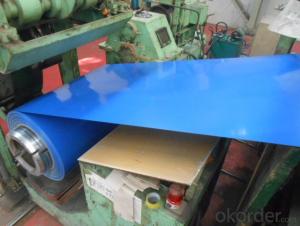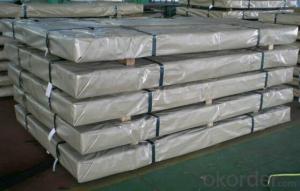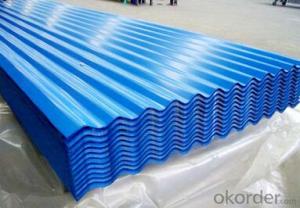Prepainted Galvanized Corrugated sheet
- Loading Port:
- Tianjin
- Payment Terms:
- TT OR LC
- Min Order Qty:
- -
- Supply Capability:
- 5000 m.t./month
OKorder Service Pledge
OKorder Financial Service
You Might Also Like
Pre painted Galvanized roofing sheet
1> thickness: 0.12mm - 4.5mm
2> width:762mm/914mm/1200mm
3> length:Any length
4> basic material: galvanized steel sheet, Aluminum steel sheet
5> Zinc (Al) coating: 60g/m2 - 270g/m2
6> shape: corrugated
7> mainly usage: roof.
8> color: RAL card
9> Package: standard export package or as customer's requirement
Full Hard Galvanized Corrugated Steel Sheet / Corrugated Steel Sheet
Certificate | corrugated sheet :ISO9001:2008 |
Standard | corrugated sheet :ASTM A653, JIS G3302 SGCC/SGCH,GB/T2518, European standard |
Grade | corrugated sheet : SGCC, SGCH, SGCD1-SGCD3, SGC340-SGC570, SGCC, DX51D |
Specification | corrugated sheet :(0.12-1.80)mm*1500mm or under |
Type | corrugated sheet :steel coil, steel sheets/ plates, corrugated steel sheets/plates |
Terms of payment | corrugated sheet :T/T or L/C |
Shipment | corrugated sheet : shipped by 20 feet container, loading about 25 tons |
Package: | corrugated sheet : seaworthy standard export package |
- Q:What is the process of polishing steel sheets?
- Achieving a smooth and shiny finish on steel sheets involves a series of steps. Firstly, the surface is cleaned to eliminate any dirt, oil, or debris, typically by employing a degreaser or solvent. Following this, abrasive materials like sandpaper or a sanding belt are utilized to sand the sheets, thus eliminating visible scratches and imperfections. Once sanded, a polishing compound or paste is usually applied and rubbed into the surface with a cloth or buffing wheel. This compound aids in removing any remaining scratches and revealing the natural shine of the steel. To further enhance the shine and smoothness, a finer polishing compound may be employed, repeating the process until the desired level of polish is achieved. Finally, the sheets are meticulously cleaned and inspected to ensure they meet the desired quality standards, including the removal of any remaining polishing compound residue and the identification of any remaining imperfections. In conclusion, the process of polishing steel sheets necessitates careful cleaning, sanding, and polishing to attain a smooth and shiny finish. The specific techniques and materials employed may vary depending on the desired level of polish and the type of steel being polished.
- Q:What is the process of forming corrugated steel sheets?
- The process of forming corrugated steel sheets involves passing a flat steel sheet through a series of rolling mills equipped with corrugating rolls. These rolls have a pattern of ridges and grooves that shape the steel sheet into a wavy or corrugated form. The sheet is fed into the first set of rolls, which press the ridges into the sheet, and then it goes through subsequent sets of rolls to further refine the corrugations. This process creates strength and rigidity in the steel sheet, making it suitable for various applications in construction, roofing, and packaging industries.
- Q:What is the difference between a painted and powder coated steel sheet?
- The application process and resulting finish distinguish painted steel sheets from powder coated steel sheets. Painted steel sheets are typically covered with a liquid paint, which can be applied through various methods such as spraying, brushing, or dipping. This liquid paint contains pigments and binders that stick to the steel surface and create a protective layer. It is possible to customize the paint in terms of color, gloss, and texture, allowing for a multitude of design options. However, painted surfaces may be susceptible to chipping, peeling, and fading over time, especially in harsh environments or with exposure to UV radiation. On the other hand, powder coated steel sheets are coated with a dry powder, which is electrostatically administered to the steel surface. The powder consists of a blend of finely ground particles, including pigments, resins, and additives. When applied, the steel sheet is heated, causing the powder particles to melt and fuse together, resulting in a sturdy and consistent coating. The outcome is a smooth, uniform finish that offers exceptional resistance to chipping, scratching, and UV radiation. Powder coating also provides a wider range of color choices and finishes compared to traditional liquid paint. In conclusion, although both painted and powder coated steel sheets offer protection and aesthetic appeal, powder coating provides superior durability, damage resistance, and a broader range of design possibilities.
- Q:Can steel sheets be used for railway applications?
- Yes, steel sheets can be used for railway applications. Steel sheets are commonly used in the construction of railway tracks, bridges, and other infrastructure due to their high strength, durability, and resistance to wear and tear. They can be formed into various shapes and sizes to meet the specific requirements of railway applications. Additionally, steel sheets can be easily welded, which allows for efficient and cost-effective installation and repair of railway components. Overall, steel sheets are a popular choice in the railway industry due to their excellent mechanical properties and ability to withstand heavy loads and harsh environmental conditions.
- Q:How thick are steel sheets available?
- Steel sheets are available in various thicknesses, ranging from as thin as 0.4 millimeters to as thick as 150 millimeters, depending on the specific application and requirements.
- Q:How do steel sheets perform in terms of impact resistance?
- Steel sheets have excellent impact resistance due to their high strength and toughness. They can withstand significant force and absorb energy, making them highly effective in resisting impacts and minimizing damage.
- Q:Are steel sheets suitable for decorative applications?
- Indeed, decorative applications can benefit from the suitability of steel sheets. The versatility, durability, and aesthetic appeal of steel sheets allow for their use in a wide range of decorative purposes. They can be easily shaped, sized, and patterned to fit different needs. Steel sheets offer various possibilities for creating decorative elements such as wall panels, room dividers, ceiling tiles, and facades. They can also be utilized for decorative accents like trims, moldings, and decorative screens. The sleek and reflective surface of steel sheets adds a touch of modernity and elegance to any space. Furthermore, steel sheets can be enhanced with different finishes and coatings to further enhance their decorative properties. These options include paints, powder coatings, patinas, and even specialized coatings like faux rust or metallic finishes. With these choices, steel sheets can complement any interior or exterior decor style, opening up a wide range of design possibilities. Additionally, steel sheets are highly durable and long-lasting, making them suitable for both indoor and outdoor decorative applications. They are resistant to corrosion, fire, and extreme weather conditions, ensuring that the decorative elements made from steel sheets maintain their appearance and functionality over time. To sum up, steel sheets are an excellent choice for decorative applications. Their versatility, durability, and aesthetic appeal make them a perfect option for creating visually appealing and long-lasting decorative elements in various settings.
- Q:Can steel sheets be used for solar panel structures?
- Yes, steel sheets can be used for solar panel structures. Steel is a popular choice for constructing solar panel structures due to its strength, durability, and versatility. Steel sheets can be easily fabricated and shaped to meet specific design requirements, making them suitable for various types of solar panel installations. Additionally, steel has excellent load-bearing capabilities, which is crucial for supporting the weight of solar panels. It is also resistant to corrosion and can withstand harsh weather conditions, making it a reliable material for long-term use in outdoor settings. Overall, the use of steel sheets for solar panel structures is a practical and cost-effective solution.
- Q:Can steel sheets be used for solar panel installations?
- Solar panel installations can indeed utilize steel sheets. With their strength and durability, steel serves as a reliable foundation for mounting solar panels. Notably, steel sheets are frequently employed in the construction of support structures like mounting frames or racks for solar panels. Their malleability allows for easy shaping and cutting to meet installation requirements. Moreover, steel's resistance to corrosion is essential for prolonged outdoor usage. Nonetheless, it is vital to ensure appropriate insulation and grounding to avert potential electrical problems associated with employing steel sheets for solar panel installations.
- Q:How do steel sheets handle thermal conductivity?
- Steel sheets possess a relatively high level of thermal conductivity, which indicates their effectiveness in the transmission of heat. This characteristic enables steel to rapidly absorb and spread heat across its entirety. When subjected to a heat source, like a flame or hot object, steel sheets swiftly conduct the heat throughout their structure, resulting in consistent heating or cooling. Consequently, steel sheets are well-suited for applications demanding heat transfer, such as radiant heating systems in the construction industry or heat exchangers in manufacturing. The elevated thermal conductivity of steel also renders it a favored material for cookware, as it guarantees uniform heat distribution and efficient cooking. However, it is crucial to acknowledge that steel's thermal conductivity can also make it susceptible to heat loss in colder environments, necessitating appropriate insulation measures to uphold desired temperatures.
1. Manufacturer Overview |
|
|---|---|
| Location | |
| Year Established | |
| Annual Output Value | |
| Main Markets | |
| Company Certifications | |
2. Manufacturer Certificates |
|
|---|---|
| a) Certification Name | |
| Range | |
| Reference | |
| Validity Period | |
3. Manufacturer Capability |
|
|---|---|
| a)Trade Capacity | |
| Nearest Port | |
| Export Percentage | |
| No.of Employees in Trade Department | |
| Language Spoken: | |
| b)Factory Information | |
| Factory Size: | |
| No. of Production Lines | |
| Contract Manufacturing | |
| Product Price Range | |
Send your message to us
Prepainted Galvanized Corrugated sheet
- Loading Port:
- Tianjin
- Payment Terms:
- TT OR LC
- Min Order Qty:
- -
- Supply Capability:
- 5000 m.t./month
OKorder Service Pledge
OKorder Financial Service
Similar products
New products
Hot products
Related keywords






























